Study on Fluid Behaviors of Foam-Assisted Nitrogen Flooding on a Three-Dimensional Visualized Fracture–Vuggy Model
Abstract
:1. Introduction
2. Experimental Preparation
2.1. Materials Used
2.2. Design of Three-Dimension Visualized Fracture–Vuggy Physical Model
2.3. Experimental Procedures
- (1)
- The three-dimensional visualized fracture–vuggy physical model experiments are vacuumed and conducted at room temperature and pressure conditions.
- (2)
- The cylinder base tank is filled with simulated formation water from the model’s bottom, while the three-dimensional visualized fracture–vuggy model body is filled with simulated oil from the model’s top.
- (3)
- The bottom water flooding is carried out at a 10 mL/min flow rate when five wells are open initially. The well TK467 is converted to an injection well with a 4 mL/min flow rate from a production well as its water cut increases to 98%; meanwhile, the velocity of bottom water is also adjusted to 4 mL/min.
- (4)
- Close one well when its water cut reaches 98% until the other wells are all closed.
- (5)
- Open all wells, and the pre-generated N2 foam is injected from TK467 with 12 mL/min flow rate. The volume of injected N2 foam is 0.5 PV (785.6 cm3). Afterwards, N2 is also injected from TK467 with 12 mL/min flow rate. The bottom water keeps the velocity of 4 mL/min during foam or N2 flooding. One well is closed when its water cut reaches 98% or N2 channeling occurs until the other wells are all closed.
3. Results and Discussions
3.1. Foam Flow Characteristics around Injection Well TK467
3.2. Foam Flow Characteristics around Production Well TK411
3.3. Synergistic Effects of Foam-Assisted N2 and Bottom Water on Interface Evolution
3.4. Foam-Assisted N2 on Mobilizing Residual Oil Formed from Water Flooding
- (1)
- Residual attic oil mobilization
- (2)
- Residual oil film and bypassed oil mobilization
3.5. Classification of Residual Oil after Foam-Assisted N2 Flooding
- (1)
- Residual oil types after nitrogen gas flooding;
- (a)
- Residual bypassed oil
- (b)
- Residual oil film
- (c)
- Residual attic oil
- (d)
- Residual oil cluster
- (2)
- Residual oil types after foam-assisted N2 flooding;
- (a)
- Residual oil in the corner
- (b)
- Residual oil drop
3.6. Dynamic Oil Recovery
4. Conclusions
Author Contributions
Funding
Institutional Review Board Statement
Informed Consent Statement
Acknowledgments
Conflicts of Interest
References
- Aftab, A.; Ismail, A.R.; Ibupoto, Z.H.; Akeiber, H.; Malghani, M.G.K. Nanoparticles based drilling muds a solution to drill elevated temperature wells: A review. Renew. Sustain. Energy Rev. 2017, 76, 1301–1313. [Google Scholar] [CrossRef]
- Rezk, M.Y.; Allam, N.K. Impact of Nanotechnology on Enhanced Oil Recovery: A Mini-Review. Ind. Eng. Chem. Res. 2019, 58, 16287–16295. [Google Scholar] [CrossRef] [Green Version]
- Hou, J.; Luo, M.; Zhu, D. Foam-EOR method in fractured-vuggy carbonate reservoirs: Mechanism analysis and injection parameter study. J. Petrol. Sci. Eng. 2018, 164, 546–558. [Google Scholar] [CrossRef]
- Akbar, M.; Vissapragada, B.; Alghamdi, A.H.; Allen, D.; Herron, M.; Carnegie, A.; Saxena, K. A Snapshot of Carbonate Reservoir Evaluation. Oilfield Rev. 2001, 12, 20–41. [Google Scholar]
- Li, Y. The theory and method for development of carbonate fractured-cavity reservoirs in Tahe oilfield. Acta Pet. Sin. 2013, 34, 115–121. [Google Scholar]
- Bai, Y.; Li, J.; Xiong, C.; Shang, X.; Wei, F.; Zhang, M. Effect of a polymer on chromium(III) diffusion during gelant injection in fractured media. J. Appl. Polym. Sci. 2016, 133, 43447. [Google Scholar] [CrossRef]
- Hou, J.; Li, H.; Jiang, Y.; Luo, M.; Zheng, Z.; Zhang, L.; Yuan, D. Macroscopic three-dimensional physical simulation of water flooding in multi-well fracture-cavity unit. Petrol. Explor. Dev. 2014, 41, 784–789. [Google Scholar] [CrossRef]
- Chen, Z.H.; Dai, Y.; Lang, Z.X. Storage-percolation modes and production performance of the karst reservoirs in Tahe Oilfield. Pet. Explor. Dev. 2005, 32, 101–105. [Google Scholar]
- Corbett, P.W.; Geiger, S.; Borges, L.; Garayev, M.; Gonzalez, J.G.; Valdez, C. Limitations in Numerical Well Rest Modelling of Fractured Carbonate Rocks. In Proceedings of the Spe Europec/eage Conference & Exhibition, Barcelona, Spain, 14–17 June 2010. [Google Scholar]
- Yousef, A.N.; Behzad, T.; Abolghasem, K.R.; Shahram, S.; Kaveh, K.; Amin, J. A combined Parzen-wavelet approach for detection of vuggy zones in fractured carbonate reservoirs using petrophysical logs. J. Pet. Sci. Eng. 2014, 119, 1–7. [Google Scholar] [CrossRef]
- Li, Y.; Jing, Q.; Zhong, J.; Zou, S. Karst zonings and fracture-cave structure characteristics of Ordovician reservoirs in Tahe oilfield, Tarim Basin. Acta Pet. Sin. 2016, 37, 289–298. [Google Scholar]
- Yong, L.; Wang, D.; Liu, Z.; Ma, X. Development Strategy Optimization of Gas Injection Huff and Puff for Fractured-Caved Carbonate Reservoirs. In Proceedings of the Spe Kingdom of Saudi Arabia Technical Symposium & Exhibition, Dammam, Saudi Arabia, 25–28 April 2016. [Google Scholar]
- Wang, D.; Li, Y.; Hu, Y.; Li, B.; Deng, X.; Liu, Z. Integrated dynamic evaluation of depletion-drive performance in naturally fractured-vuggy carbonate reservoirs using DPSO–FCM clustering. Fuel 2016, 181, 996–1010. [Google Scholar] [CrossRef]
- Wu, X.; Hou, J.; Zheng, Z.; Luo, M.; Gao, Y. Effect of bottom water on subsequent water flooding and gas drive in fractured-vuggy carbonate oil reservoir. Pet. Geol. Recovery Effic. 2016, 23, 111–115. [Google Scholar]
- Gong, Y.; Gu, Y. Experimental Study of Water and CO2 Flooding in the Tight Main Pay Zone and Vuggy Residual Oil Zone of a Carbonate Reservoir. Energy Fuel 2015, 29, 6213–6223. [Google Scholar] [CrossRef]
- Hou, J.-R.; Zheng, Z.-Y.; Song, Z.-J.; Luo, M.; Li, H.-B.; Zhang, L.; Yuan, D.-Y. Three-dimensional physical simulation and optimization of water injection of a multi-well fractured-vuggy unit. Pet. Sci. 2016, 13, 259–271. [Google Scholar] [CrossRef] [Green Version]
- Li, Y.-B.; Pu, W.-F.; Wei, B.; Chen, Y.-F.; Bai, B.-J. The feasibility of CO2 and N2 injection for the Tahe fracture-cavity carbonate extra-heavy oil reservoir: An experimental study. Fuel 2018, 226, 598–606. [Google Scholar] [CrossRef]
- Lyu, X.; Liu, Z.; Hou, J.; Lyu, T. Mechanism and influencing factors of EOR by N2 injection in fractured-vuggy carbonate reservoirs. J. Nat. Gas Sci. Eng. 2017, 40, 226–235. [Google Scholar] [CrossRef]
- Yuan, D.; Hou, J.; Song, Z.; Wang, Y.; Luo, M.; Zheng, Z. Residual oil distribution characteristic of fractured-cavity carbonate reservoir after water flooding and enhanced oil recovery by N2 flooding of fractured-cavity carbonate reservoir. J. Petrol. Sci. Eng. 2015, 129, 15–22. [Google Scholar] [CrossRef]
- Yuan, D.; Hou, J.; Wang, Z.; Su, W.; Zhao, D. Research of N2 flooding and N2 foam flooding for EOR in fractured-vuggy carbonate reservoirs of the Tahe oil field. Geol. Explor. 2016, 52, 791–798. [Google Scholar]
- Su, W.; Hou, J.; Zhao, T.; Xi, Y.; Cui, C. Experimental investigation on continuous N2 injection to improve light oil recovery in multi-wells fractured-cavity unit. Petroleum 2017, 3, 367–376. [Google Scholar] [CrossRef]
- Qu, M.; Hou, J.; Qi, P.; Zhao, F.; Ma, S.; Churchwell, L.; Wang, Q.; Li, H.; Yang, T. Experimental study of fluid behaviors from water and nitrogen floods on a 3-D visual fractured-vuggy model. J. Petrol. Sci. Eng. 2018, 166, 871–879. [Google Scholar] [CrossRef]
- Hou, J.R.; Zhang, L.; Li, H.B. Influencing factors on EOR nitrogen flooding in fractured-vuggy carbonate reservoir. Pet. Geol. Recovery Effic. 2015, 22, 64–68. [Google Scholar]
- Wang, Y.; Ge, J.; Zhang, G. Foaming Properties of Commercial Lauramide Amide Oxide in High-Salinity Water. J. Surfactants Deterg. 2017, 20, 755–760. [Google Scholar] [CrossRef]
- Zhu, D.; Bai, B.; Hou, J. Polymer Gel Systems for Water Management in High-Temperature Petroleum Reservoirs: A Chemical Review. Energy Fuels 2017, 31, 13063–13087. [Google Scholar] [CrossRef]
- Telmadarreie, A.; Trivedi, J. Evaluation of foam generated with the hydrocarbon solvent for extra-heavy oil recovery from fractured porous media: Pore-scale visualization. J. Petrol. Sci. Eng. 2017, 157, 1170–1178. [Google Scholar] [CrossRef]
- Yang, H.; Shao, S.; Zhu, T.; Chen, C.; Liu, S.; Zhou, B.; Hou, X.; Zhang, Y.; Kang, W. Shear resistance performance of low elastic polymer microspheres used for conformance control treatment. J. Ind. Eng. Chem. 2019, 79, 295–306. [Google Scholar] [CrossRef]
- Xu, X.; Saeedi, A.; Liu, K. An experimental study of combined foam/surfactant polymer (SP) flooding for carbone dioxide-enhanced oil recovery (CO2-EOR). J. Petrol. Sci. Eng. 2017, 149, 603–611. [Google Scholar] [CrossRef] [Green Version]
- Liang, T.; Hou, J. Fluids flow behaviors of nitrogen and foam-assisted nitrogen floods in 2D visual fault-karst carbonate reservoir physical models. J. Petrol. Sci. Eng. 2021, 200, 108286. [Google Scholar] [CrossRef]
- Liang, T.; Hou, J.; Qu, M.; Song, C.; Li, J.; Tan, T.; Lu, X.; Zheng, Y. Flow behaviors of nitrogen and foams in micro-visual fracture-vuggy structures. RSC Adv. 2021, 11, 28169–28177. [Google Scholar] [CrossRef]
- Singh, R.; Mohanty, K.K. Foam flow in a layered, heterogeneous porous medium: A visualization study. Fuel 2017, 197, 58–69. [Google Scholar] [CrossRef]
- Wang, D.; Hou, Q.; Luo, Y.; Zhu, Y.; Fan, H. Blocking Ability and Flow Characteristics of Nitrogen Foam Stabilized with Clay Particles in Porous Media. J. Dispers. Sci. Technol. 2015, 36, 170–176. [Google Scholar] [CrossRef]
- Zhang, Y.; Chang, Z.; Luo, W.; Gu, S.; Li, W.; An, J. Effect of starch particles on foam stability and dilational viscoelasticity of aqueous-foam. Chin. J. Chem. Eng. 2015, 23, 276–280. [Google Scholar] [CrossRef]
- Wu, Z.; Liu, H.; Pang, Z.; Wu, Y.; Wang, X.; Liu, D.; Gao, M. A visual investigation of enhanced heavy oil recovery by foam flooding after hot water injection. J. Petrol. Sci. Eng. 2016, 147, 361–370. [Google Scholar] [CrossRef]
- Simjoo, M.; Zitha, P.L.J. Effects of Oil on Foam Generation and Propagation in Porous Media. In Proceedings of the SPE Enhanced Oil Recovery Conference. Society of Petroleum Engineers, Kuala Lumpur, Malaysia, 2–4 July 2013; p. 16. [Google Scholar]
- Bai, Y.; Li, J.; Zhou, J. Sensitivity analysis of similar parameters in physical simulation of two phase flow in water drive. Sci. China Ser. E Eng. Mater. Sci. 2005, 35, 761–772. [Google Scholar]
- Yang, J.; Hou, J.; Qu, M.; Liang, T.; Wen, Y. Experimental study the flow behaviors and mechanisms of nitrogen and foam assisted nitrogen gas flooding in 2-D visualized fractured-vuggy model. J. Pet. Sci. Eng. 2020, 194, 107501. [Google Scholar] [CrossRef]
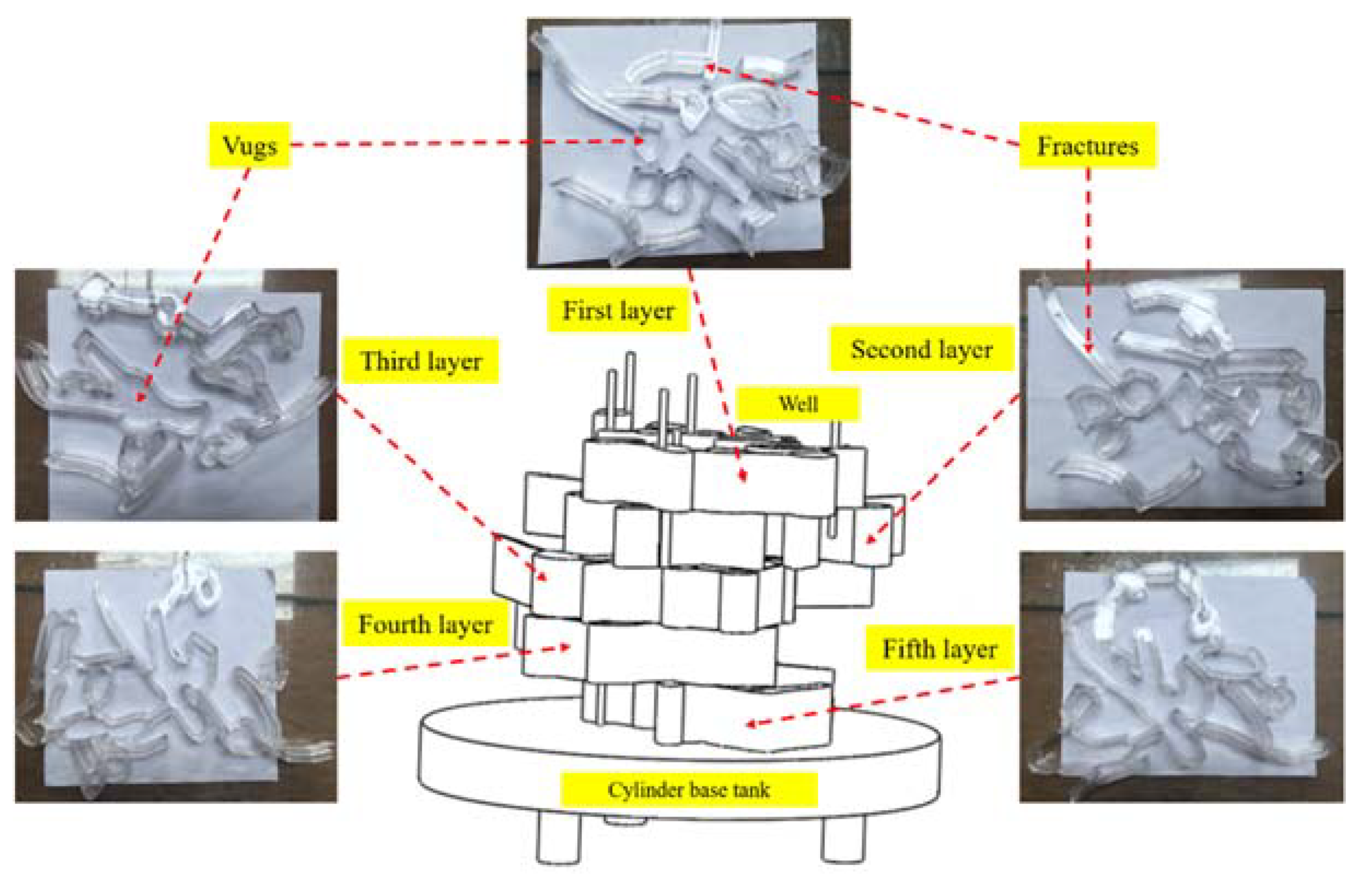
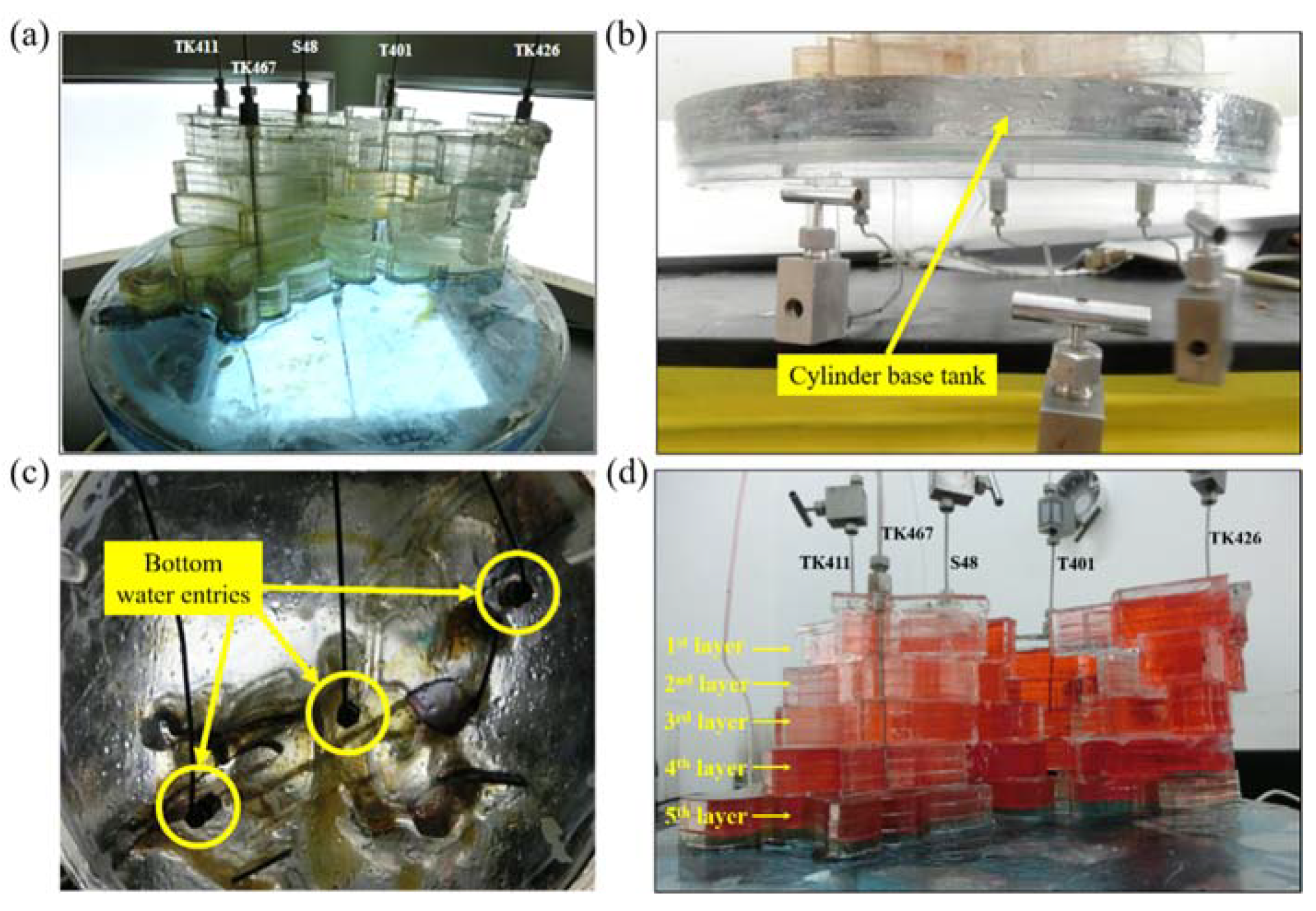
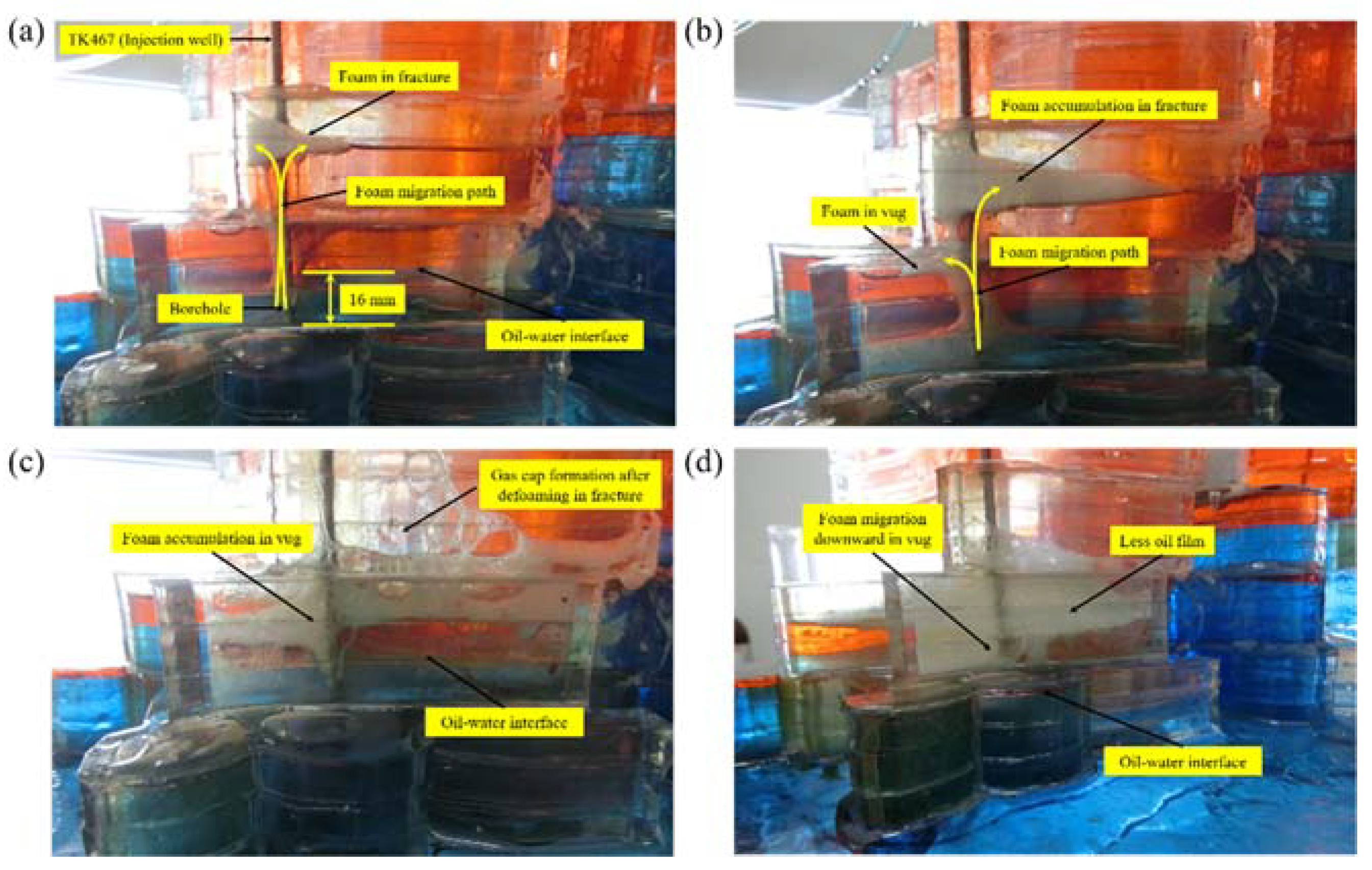

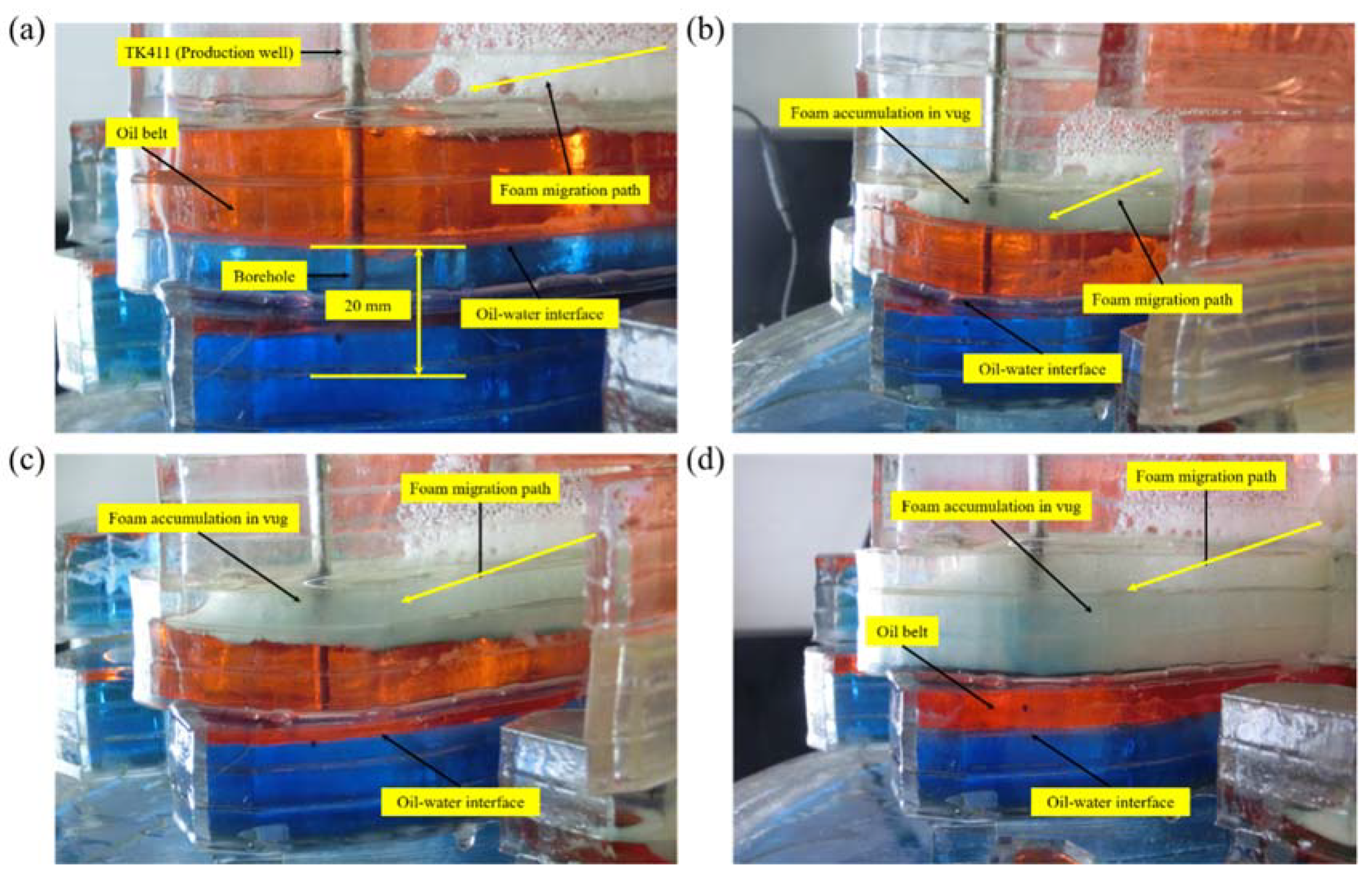

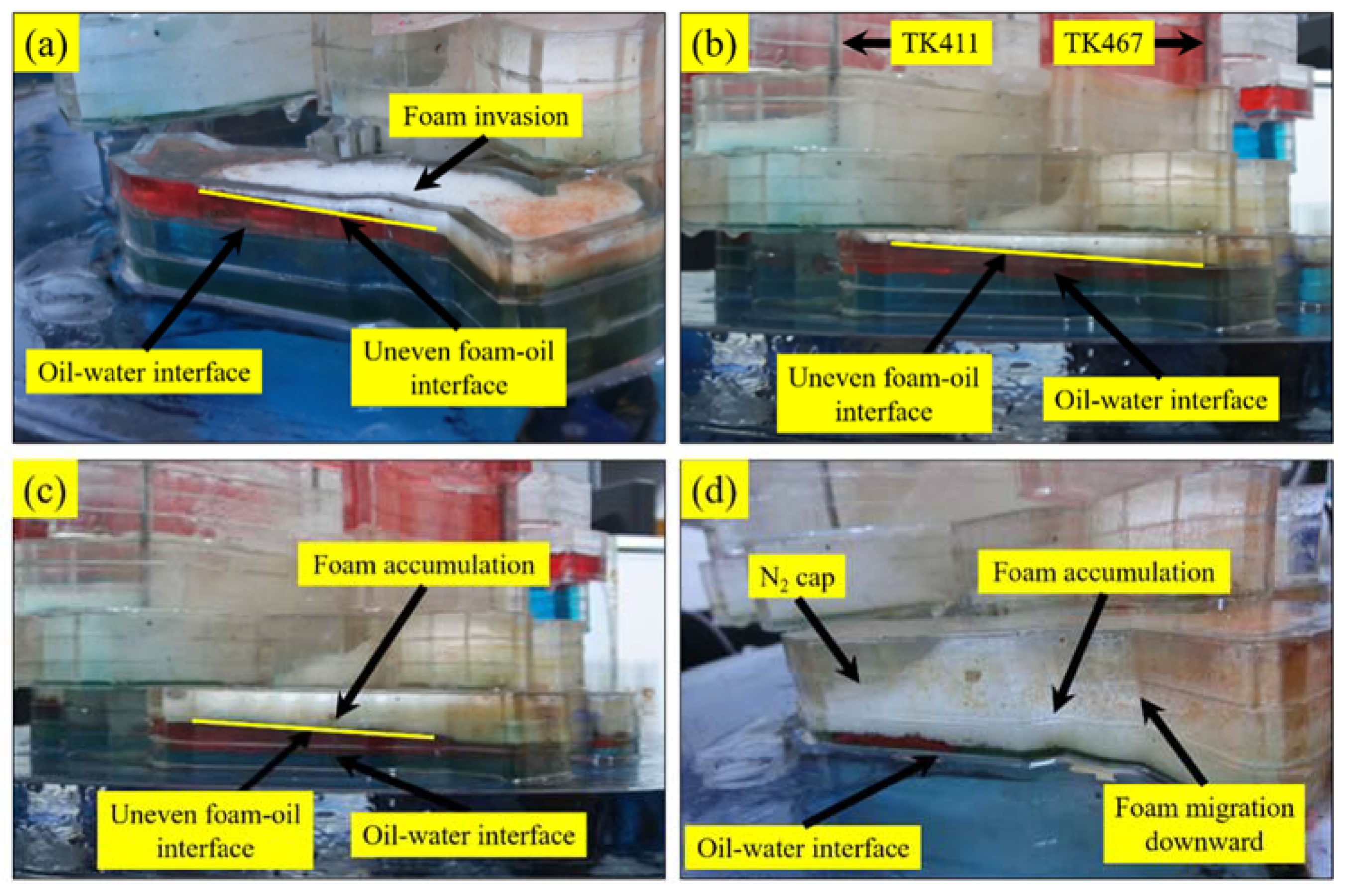
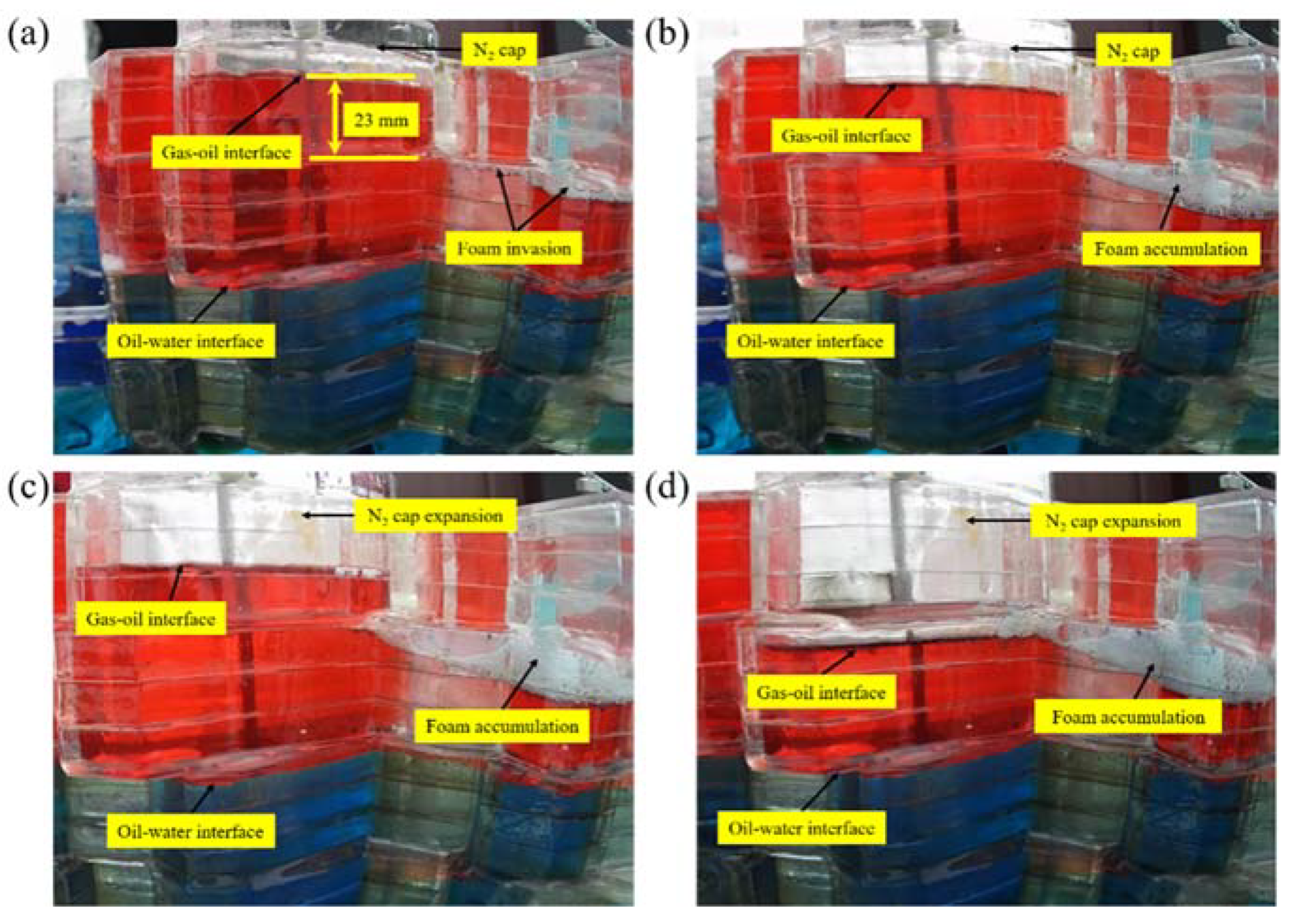



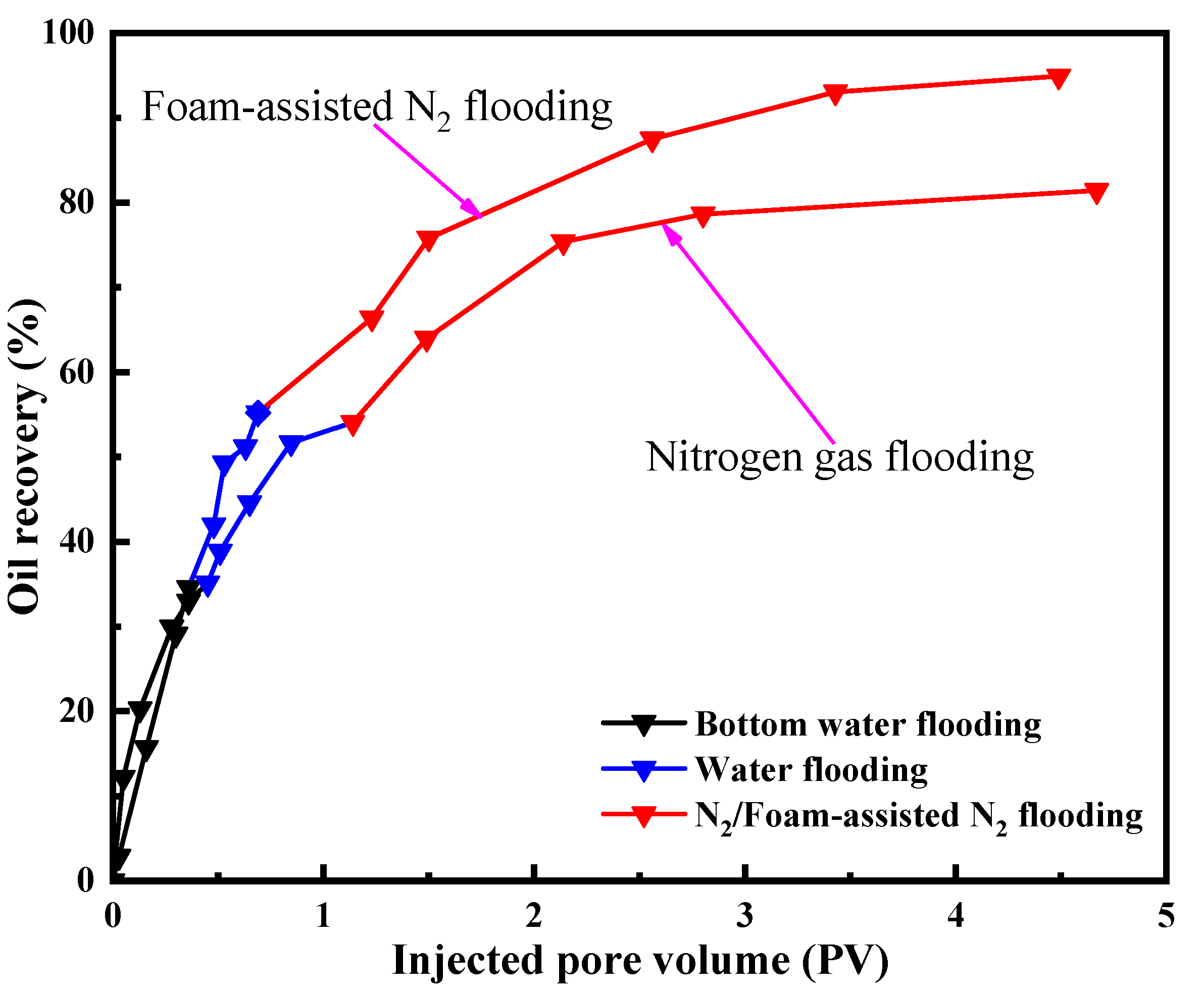
| Salinity (mg/L) | Inorganic Salt Concentration (mg/L) | ||||
|---|---|---|---|---|---|
| Na2SO4 | NaHCO3 | NaCl | CaCl2 | MgCl2 | |
| 253,407 | 417 | 576 | 207,759 | 41,106 | 3549 |
| Similarity Types | Similarity Criteria | Physical Interpretation | Similarity Criterion Index |
|---|---|---|---|
| Geometric similarity | Vug diameter divided by the well-controlled diameter | 0.95–1.05 | |
| Fracture width divided by the well-controlled diameter | 0.97–1.03 | ||
| Motion similarity | Recovery velocity divided by the injection velocity | 0.98–1.02 | |
| Dynamic similarity | Inertial force divided by the viscous force | 0.99–1.01 |
| Factors | Actual Reservoir | Three-Dimensional Visualized Model |
|---|---|---|
| Vug diameter (d)/cm | 250–3000 | 1.5–15 |
| Oil viscosity (μ)/(mPa·s) | 18.3–29.7 | 19–65 |
| Oil density (ρo)/(g·cm−3) | 0.91 | 0.82 |
| Gravity acceleration (g)/(m·s−2) | 9.8 | 9.8 |
| Injection velocity (Q)/(m3·d−1) | 8–55 | 0.002–0.025 |
| Well diameter (r)/mm | 120 | 3 |
| Fracture width (w)/mm | 0.3–7 | 1.5–5.0 |
| Well Name | Well Height (cm) | Well Type | Coordination Number |
|---|---|---|---|
| TK411 | 10.8 | Vug well, production well | 3 |
| TK467 | 18.0 | Fracture well, convert well | 1 |
| S48 | 14.8 | Vug well, production well | 4 |
| T401 | 12.2 | Vug well, production well | 2 |
| TK426 | 9.2 | Fracture well, production well | 4 |
| Stage | EOR during Bottom Water Flooding (%) | EOR during Water Flooding (%) | EOR during Foam-Assisted N2 Flooding (%) | EOR during Nitrogen Gas Flooding (%) | |
|---|---|---|---|---|---|
| Technologies | |||||
| Foam-assisted N2 technology | 34.60 | 20.60 | 39.70 | / | |
| Nitrogen gas technology | 35.08 | 18.99 | / | 27.34 | |
Publisher’s Note: MDPI stays neutral with regard to jurisdictional claims in published maps and institutional affiliations. |
© 2021 by the authors. Licensee MDPI, Basel, Switzerland. This article is an open access article distributed under the terms and conditions of the Creative Commons Attribution (CC BY) license (https://creativecommons.org/licenses/by/4.0/).
Share and Cite
Qu, M.; Liang, T.; Hou, J. Study on Fluid Behaviors of Foam-Assisted Nitrogen Flooding on a Three-Dimensional Visualized Fracture–Vuggy Model. Appl. Sci. 2021, 11, 11082. https://doi.org/10.3390/app112311082
Qu M, Liang T, Hou J. Study on Fluid Behaviors of Foam-Assisted Nitrogen Flooding on a Three-Dimensional Visualized Fracture–Vuggy Model. Applied Sciences. 2021; 11(23):11082. https://doi.org/10.3390/app112311082
Chicago/Turabian StyleQu, Ming, Tuo Liang, and Jirui Hou. 2021. "Study on Fluid Behaviors of Foam-Assisted Nitrogen Flooding on a Three-Dimensional Visualized Fracture–Vuggy Model" Applied Sciences 11, no. 23: 11082. https://doi.org/10.3390/app112311082






